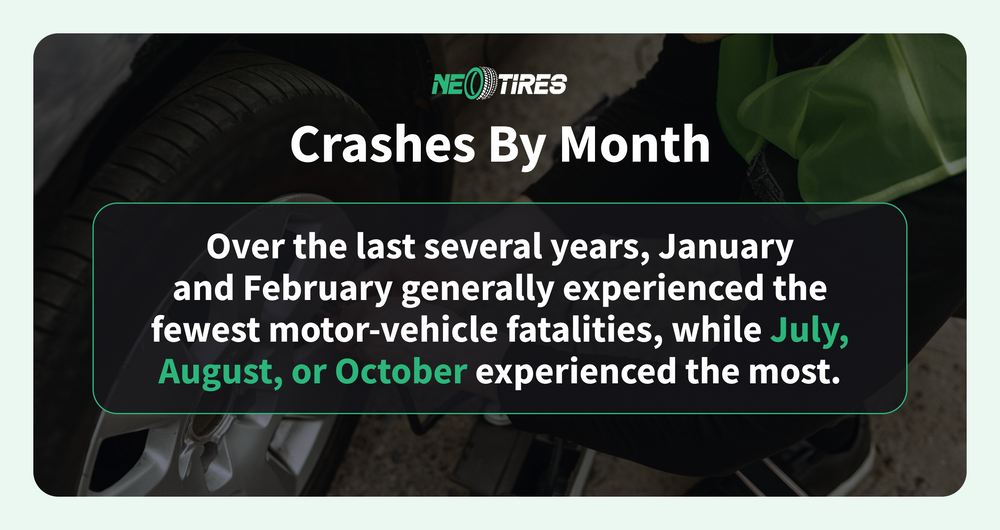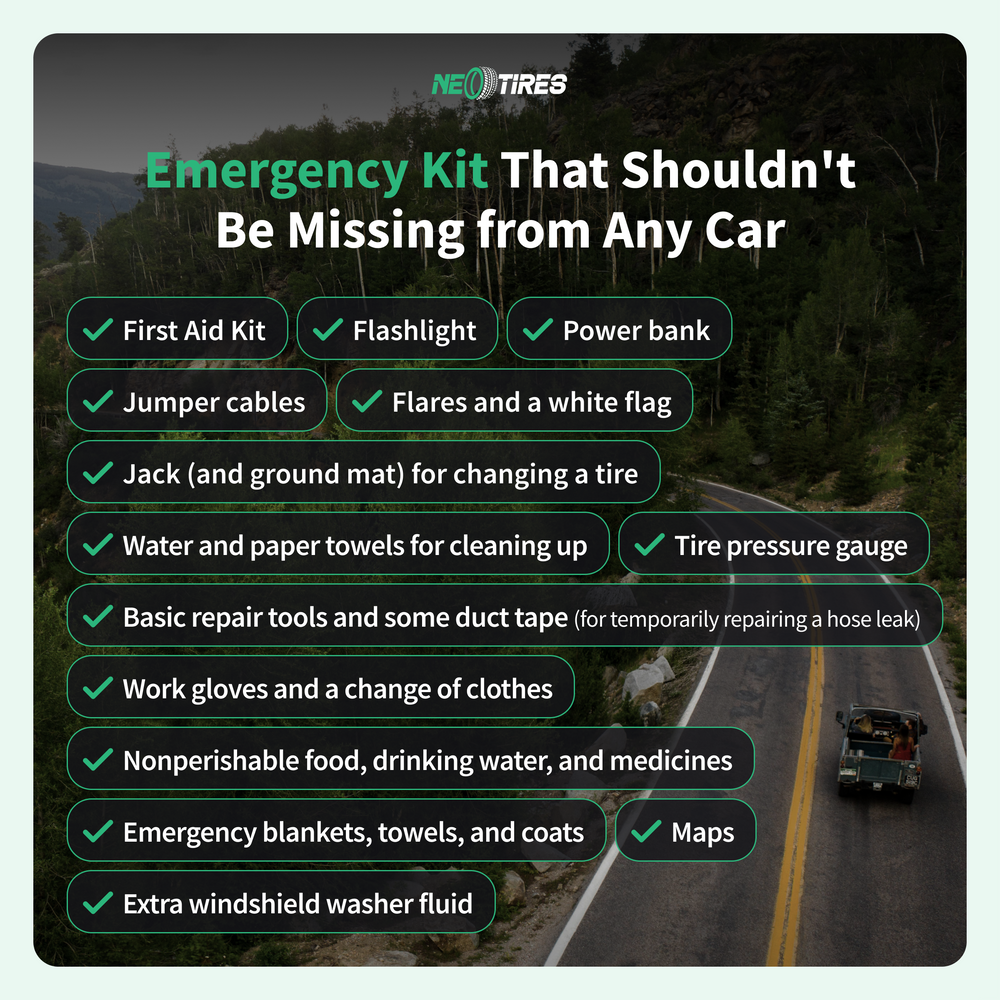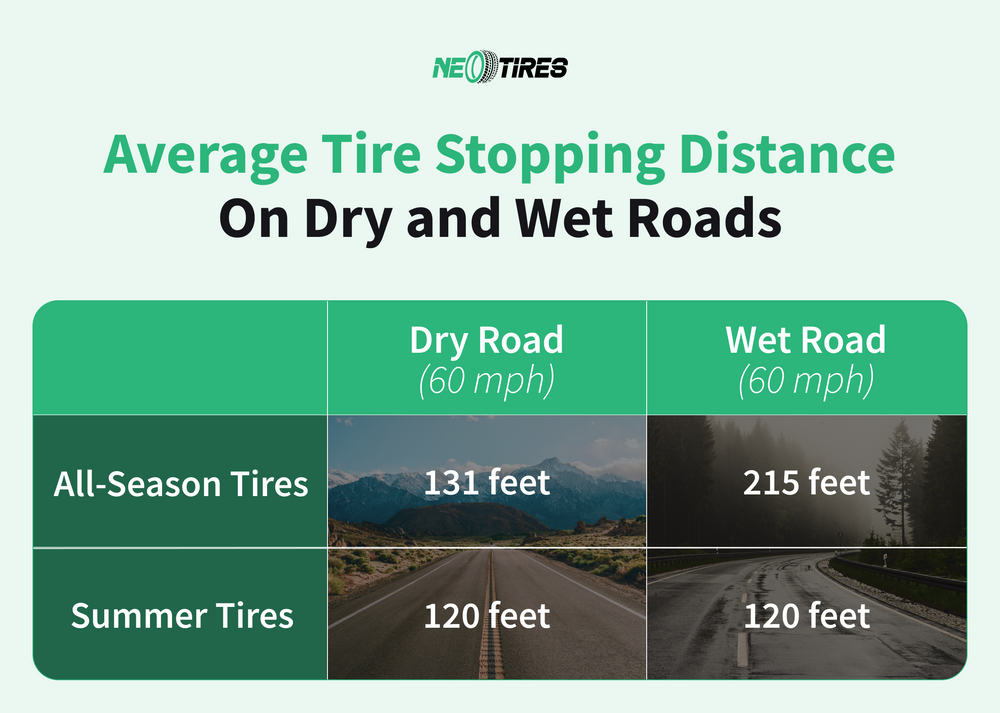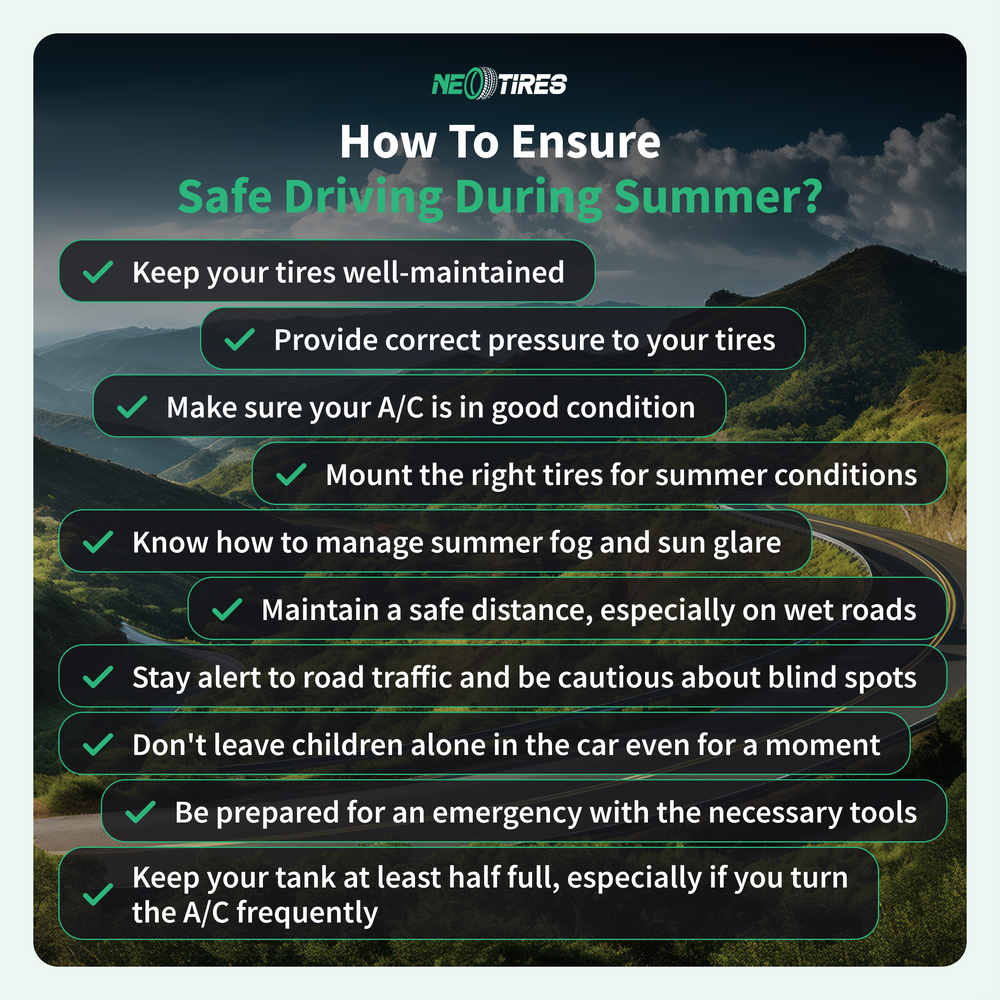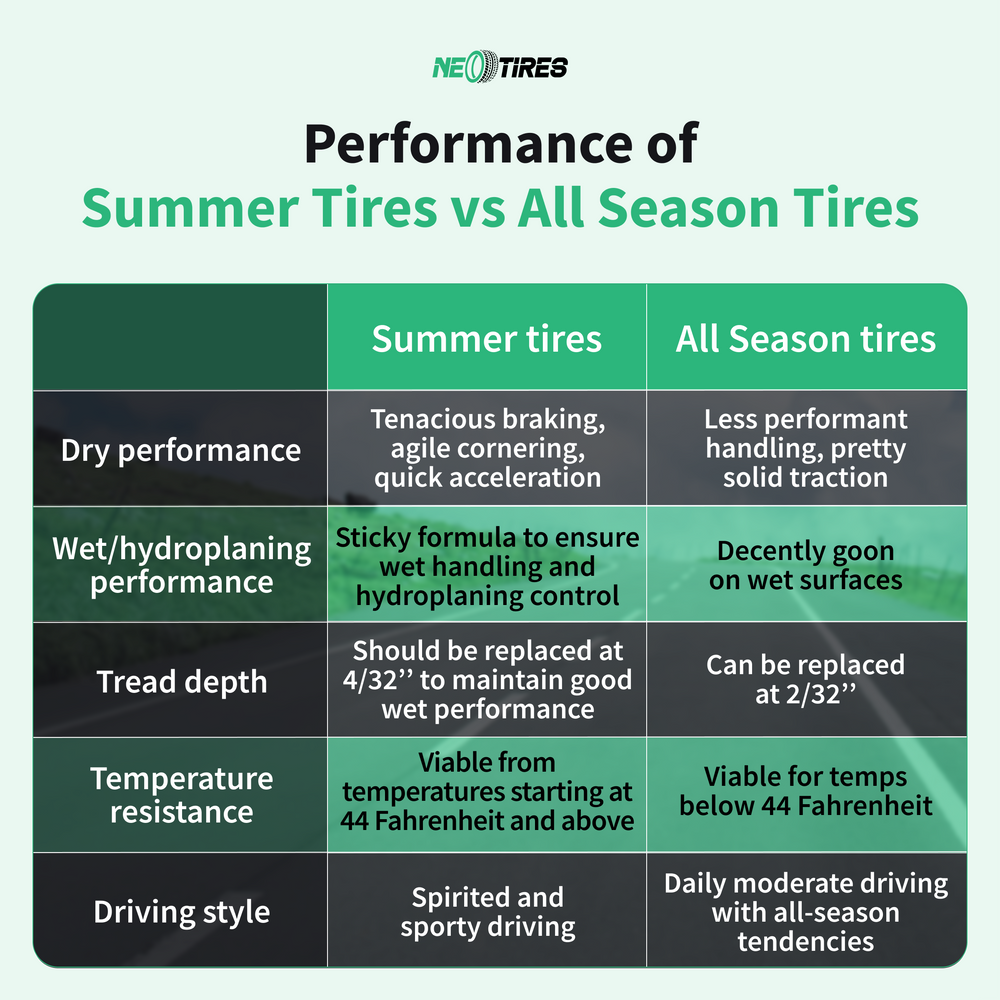According to the Insurance Institute for Highway Safety (IIHS), the highest number of car accidents occur during summer. This is explained by drivers feeling more confident on dry roads. This false sense of driving confidence makes them push the limits and squeeze all the potential of their vehicles.
Unfortunately, this increases the risk of losing control over the vehicle, which results in moderate to serious collisions. This article is about ensuring safer driving during the summer period and what steps drivers should follow to improve summer driving experiences.
How Do You Drive Safe During Summer?
Consider the following seven tips to drive safer during summer:
- conduct comprehensive summer vehicle checks (ensure proper summer/all-season tires; ensure optimal pressure/ inspect them for damage and signs of wear);
- check the cooling system to avoid overheating;
- ensure the car emergency kit contains all necessary supplies (first aid kit, flashlight, phone charger, tire change kit, etc...);
- maintain a safe distance on both dry and wet surfaces;
- stay vigilant in summer conditions like sun glare or fog;
- keep the tank at least half full to avoid being stranded, especially on long travels;
- ensure windshield fluid and wipers are in good condition to avoid visibility issues;
Summer Vehicle Checks
Summer vehicle check means inspecting the car for brake pads, suspension, lights, hoses, radiator, and coolant for proper fluid levels, air conditioning systems, tires, and any other component/system that heat can exacerbate during summer. Consider a professional check-up especially if planning long trips to ensure optimal vehicle service.
Choose the Right Tires
Drivers should opt for summer or all-season tires for the summer season. These are designed to handle dry and wet roads and provide dependable traction on hot asphalt. Tires should be in optimal condition to resist summer heat, meaning no uneven wear or signs of damage (cracks/bulges) should be visible. Consider the right speed and load rating according to your summer driving habits and conditions.
| Condition | Summer Tires | All-Season Tires |
| Driving Climate | Hot climates with consistently high temperatures | Moderate climates with occasional rain or cooler nights |
| Road Type | High-performance driving on highways or dry roads | Mixed urban and suburban roads |
| Driving Frequency | Regular long-distance or high-speed travel | Daily commutes and moderate mileage |
| Performance Priority | Maximum grip and handling | Versatility and comfort |
| Wet Performance | Superior traction on dry and mildly wet surfaces | Better for mixed wet and dry conditions |
| Tire Longevity | Shorter lifespan but optimized for heat | Longer lifespan but less optimal for extreme heat |
| Budget | Higher upfront cost but better performance | More economical |
Tab.1 Choosing Between All-Season and Summer Tires for the Summer Season
| Driving Habit | Recommended Speed Rating | Recommended Load Rating | Tire Type |
| City Commuter | T (118 mph) | Standard (per vehicle spec) | All-Season or Summer |
| Highway Driving | H (130 mph) or V (149 mph) | Slightly higher if carrying cargo | Summer preferred |
| Performance Driving | W (168 mph) or Y (186 mph) | High-performance rating | Summer tires only |
| Occasional Long Trips | H (130 mph) | Match vehicle specification | All-Season or Summer |
| Heavy Loads or Towing | Standard speed rating | Reinforced/XL for heavy loads | All-Season (if towing frequently) |
Tab. 2. Recommended Speed Ratings and Load Ratings by Driving Habits in Summer Conditions
Adjust Tire Pressure Regularly
During the summer season, tires' PSI tends to increase as the air in them expands due to higher temperatures. Driving on overinflated tires leads to lower traction, possible blowouts, and uneven tread wear. Check and adjust tire pressure at least once a week to match the manufacturer's recommendations.
Check the Cooling System
Ensure the vehicle's cooling system is functioning to prevent engine overheating. Drivers should inspect hoses (for cracks/leaks), if the radiator cap is sealed correctly, and refill the coolant if necessary.
Check the Emergency Kit
Several essential tools are mandatory to save you in a summer-driving emergency. This includes a portable phone charger, a first aid kit, jumper cables, a flashlight, a power bank, basic tire repair tools, utensils for changing a tire (jack, jack stands, lug wrench, pressure gauge), non-perishable food and water, work gloves, and extra windshield fluid. Think beforehand about any other tool you might need during an emergency and make sure to place it in the car before hitting long summer journeys.
Maintain a Safe Distance on Dry and Wet Surfaces
Summer dry roads can give a false sense of safe driving, empowering drivers to push their limits. With higher speed, the driver can lose control of the vehicle, especially in sun glare or fog. Wet summer roads increase the braking distance, especially during rain. Maintaining a safe distance on summer wet and dry roads allows for better visibility and more time to react in case of a sudden stop.
Stay Vigilant in Sun Glare or Fog
Summer fog and sun glare reduce visibility, leading to potential driving issues (temporary blindness, difficulty judging distances, reduced reaction time, missing road signals). To improve sun glare or fog visibility, consider keeping a safe distance, maintaining a clean windshield, using low-beam headlights (for foggy conditions), and wearing sunglasses (in sun glare conditions). A sun visor extender can also be helpful for additional protection.
Keep The Tank At Least Half Full
A full or half-full tank during summer diminishes the risk of condensation in the tank and keeps the fuel pump cool. Also, this provides peace of mind whenever driving long distances in remote areas where gas stations are hardly reachable.
Summer Driving: FAQs
How To Ensure Safe Driving During Summer?
What Are the Risks of Summertime Driving?
Summer driving risks include tire blowouts (because of high temperatures, especially in underinflated tires), sun glare (reduced visibility), false sense of safety (leading to higher speed and losing control over the vehicle), engine overheating, longer braking distance with improper tires, especially in wet conditions, summer storms (slippery roads due to rain, hydroplaning), crowded roads (more traffic, more pedestrians, cyclists, and higher motorcycle activity), driver dehydration (leading to driving fatigue).
Is It Better To Get Summer Tires or All-Season Tires?
While both can be used during the summer, choose the ones that best meet your needs. All-season tires provide seasonal versatility and can be used in any weather conditions. Yet, they provide less grip, handling, and performance compared to summer tires. So, their capabilities are acceptable but not exceptional.
On the other hand, summer tires excel in terms of dynamics, handling, and braking, as well as superbly resisting excessive temperatures. Their trade-off is their shorter service life. This disadvantage is generally forgiven in favor of their ultra-high performances.
Drive Safe This Summer with the Right Tires!
Summer driving demands the right tire choice, considering the long road trips, hot pavement, and frequent rain. At NeoTires, you will find the top recommended summer tires to fit your needs, budget, and performance expectations.
Explore our summer-ready tires, crafted for dry and wet grip, fuel efficiency, and durability. Contact us if you are unsure which model best suits your needs. We are here to help you improve your driving experience!
Why Trust NeoTires?
The NeoTires team does everything possible to improve drivers' experiences in all road and weather conditions. We have assembled a team of qualified professionals in the automotive industry who can guide you through any tire-related concern.
We are here to help you choose the right tires from the thousands of products available. Our goal is to match the correct tires to each driver's unique needs.
With the right tires, you can face any challenge, whether snowy, rainy, rocky, or sandy, hassle-free. Feel free to contact us anytime for qualified assistance. Drive safe, and choose your tires wisely!





